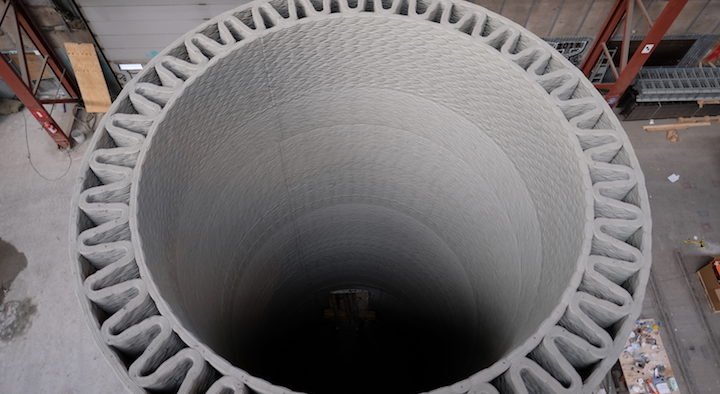

(Photo credit: GE)
2020 could be the year for 3-D printing in construction. Earlier this week, we saw news about Thinking Huts’ plans to print out a school for the Southeastern Anosy region of Madagascar. But now, GE Renewable Energy has plans to use the technology as well.
The company has partnered with COBOD and LafargeHolcim to co-develop wind turbines with optimized 3-D printed concrete bases that will achieve heights of up to 200 meters. Usually, the turbine towers have been limited to heights under 100 meters, but with taller ones, the partners plan to increase renewable energy production and use.
While GE Renewable Energy will share its expertise for the design, manufacture and commercialization of the turbines, COBOD will be responsible for the robotics automation and 3-D printing. LafargeHolcim’s share of the project consists of designing the concrete material, as well as its processing and application.
“Concrete 3-D printing is a very promising technology for us, as its incredible design flexibility expands the realm of construction possibilities,” LafargeHolcim Head of R&D Edelio Bermejo said. “Being both a user and promoter of clean energy, we are delighted to be putting our material and design expertise to work in this groundbreaking project, enabling cost efficient construction of tall wind turbine towers and accelerating access to renewable energy.”
COBOD International A/S founder Henrik Lund-Nielsen added that his company was proud to be working with LafargeHolcim and GE Renewable Energy. “With our groundbreaking 3-D printing technology combined with the competence and resources of our partners, we are convinced that this disruptive move within the wind turbines industry will help drive lower costs and faster execution times, to benefit customers and lower the CO2 footprint from the production of energy,” he stated.
“3-D printing is in GE’s DNA and we believe that large format additive manufacturing will bring disruptive potential to the wind industry,” GE Renewable Energy Advanced Manufacturing Technology Leader Matteo Bellucci added. “Concrete printing has advanced significantly over the last five years and we believe is getting closer to [having] real [applications] in the industrial world. We are committed to taking full advantage of this technology both from the design flexibility it allows as well as for the logistic simplification it enables on such massive components.”
